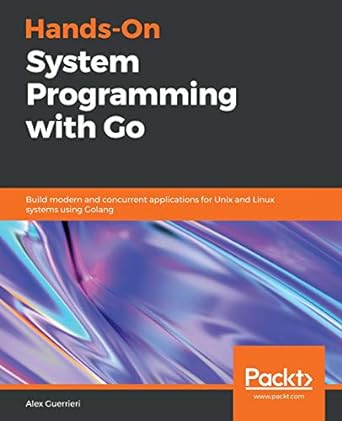Go back


Hands On System Programming With Go Build Modern And Concurrent Applications For Unix And Linux Systems Using Golang(1st Edition)
Authors:
Alex Guerrieri

Cover Type:Hardcover
Condition:Used
In Stock
Shipment time
Expected shipping within 2 DaysPopular items with books
Access to 30 Million+ solutions
Free ✝
Ask 50 Questions from expert
AI-Powered Answers
✝ 7 days-trial
Total Price:
$0
List Price: $39.99
Savings: $39.99(100%)
Solution Manual Includes
Access to 30 Million+ solutions
Ask 50 Questions from expert
AI-Powered Answers
24/7 Tutor Help
Detailed solutions for Hands On System Programming With Go Build Modern And Concurrent Applications For Unix And Linux Systems Using Golang
Price:
$9.99
/month
Book details
ISBN: 1789804078, 978-1789804072
Book publisher: Packt Publishing (July 5, 2019)
Get your hands on the best-selling book Hands On System Programming With Go Build Modern And Concurrent Applications For Unix And Linux Systems Using Golang 1st Edition for free. Feed your curiosity and let your imagination soar with the best stories coming out to you without hefty price tags. Browse SolutionInn to discover a treasure trove of fiction and non-fiction books where every page leads the reader to an undiscovered world. Start your literary adventure right away and also enjoy free shipping of these complimentary books to your door.
Book Summary: Explore the fundamentals of systems programming starting from kernel API and filesystem to network programming and process communicationsKey FeaturesLearn how to write Unix and Linux system code in Golang v1.12 Perform inter-process communication using pipes, message queues, shared memory, and semaphores Explore modern Go features such as goroutines and channels that facilitate systems programming Book DescriptionSystem software and applications were largely created using low-level languages such as C or C++. Go is a modern language that combines simplicity, concurrency, and performance, making it a good alternative for building system applications for Linux and macOS. This Go book introduces Unix and systems programming to help you understand the components the OS has to offer, ranging from the kernel API to the filesystem, and familiarize yourself with Go and its specifications. You'll also learn how to optimize input and output operations with files and streams of data, which are useful tools in building pseudo terminal applications. You'll gain insights into how processes communicate with each other, and learn about processes and daemon control using signals, pipes, and exit codes. This book will also enable you to understand how to use network communication using various protocols, including TCP and HTTP. As you advance, you'll focus on Go's best feature-concurrency helping you handle communication with channels and goroutines, other concurrency tools to synchronize shared resources, and the context package to write elegant applications. By the end of this book, you will have learned how to build concurrent system applications using GoWhat you will learnExplore concepts of system programming using Go and concurrency Gain insights into Golang's internals, memory models and allocation Familiarize yourself with the filesystem and IO streams in general Handle and control processes and daemons' lifetime via signals and pipes Communicate with other applications effectively using a network Use various encoding formats to serialize complex data structures Become well-versed in concurrency with channels, goroutines, and sync Use concurrency patterns to build robust and performant system applicationsWho this book is forIf you are a developer who wants to learn system programming with Go, this book is for you. Although no knowledge of Unix and Linux system programming is necessary, intermediate knowledge of Go will help you understand the concepts covered in the bookTable of ContentsAn Introduction to System ProgrammingUnix OS ComponentsAn Overview of GoWorking with the FilesystemHandling StreamsBuilding Pseudo-TerminalsHandling Processes and DaemonsExit Codes, Signals, and PipesNetwork ProgrammingData Encoding Using GoDealing with Channels and GoroutinesSynchronization with sync and atomicCoordination Using ContextImplementing Concurrency PatternsUsing ReflectionUsing CGO
Customers also bought these books
Frequently Bought Together
Top Reviews for Books
May Flowers
( 4 )
"Delivery was considerably fast, and the book I received was in a good condition."










